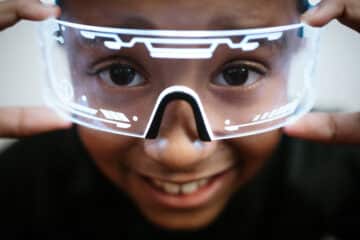While compulsory school typically starts between the ages of 6 and 7 for children around the world, more and more countries are paying greater attention to offering high quality learning experiences for students as young as age 3. In particular, recent research has suggested that high-quality early learning experiences can improve outcomes for learners in a range of areas. As The Economist’s Starting Well Index has argued, there are at least three justifications for investing in early childhood education: “From neuro-scientific research, we understand the criticality of early brain development; from social science research, we know that high quality programs improve children’s readiness for school and life; and from econometric research, we know that high quality programs save society significant amounts of money over time” (p. 5). These promising outcomes have led policymakers to expand access to these programs, with a focus toward offering quality early learning opportunities to all low-income students. Although the exact components of early childhood programs that most improve student outcomes later in life are still little understood, top performers are also putting in place sophisticated systems to assess the quality of early childhood providers and educators, and enable them to continuously improve.
Different countries organize supports for children and families differently from the United States, with most offering more extensive health services and social supports for families as well as income support. Preschool is defined differently than in the U.S. in some cases as well, serving different age groups of children in childcare centers, preschools and kindergartens. And some view the divide between preschool education and early childcare differently from the United States as well. These differences beg the question: what is a common definition of “early childhood education”?
The Starting Well Index provides a useful framework for such a definition. Early childhood education:
- Serves children between three and six
- Has a curriculum with “educational properties,” broadly defined, although many do include play-based components
- Staff must have some form of educational credential
- The educational program is based either in a school or a dedicated center
With this definition in place, the remainder of this article will explore how select top performing jurisdictions have managed these two policy imperatives: expanding access and improving quality in early childhood education. While these two strands may seem simple, as we will see, they draw on many other strands of education policy, including curriculum development, program evaluation, teacher preparation and qualification, and dedicated funding for the disadvantaged. Given the complex nature of this work, the top performers are in somewhat different places in building and maintaining a coherent system for early childhood education. However, all share a commitment to expanding learning opportunities for the youngest and most disadvantaged students, and realizing early education’s demonstrated potential for closing achievement gaps. Let’s take a closer look at how they are getting there.
How Are the Top Performers Expanding Access?
Although there have been efforts to arrive at a common international definition for early childhood education, countries may mean different things when they talk about it. Part of this confusion comes from the differing ages at which children start compulsory school: age 5 or 6 in the United States, 6 in Canada, 7 in Finland and Estonia, for example. Therefore, early childhood education can refer to learning opportunities that target children who are anywhere from age 3 to age 6, depending on the context.
No matter what the exact ages, what does not vary is the commitment of many of the top performers to expanding learning opportunities to students at younger and younger ages. For example, in Finland, 98 percent of 6-year-olds now participate in some form of schooling, despite this preceding the compulsory education age. Moreover, 68 percent of 5-year-olds and 59 percent of 4-year-olds are in early childhood education as well. And these numbers are growing rapidly: only 56 percent of 5-year-olds, and 47 percent of 4-year-olds, participated in 2005. The picture is similar in Ontario, Canada, where 92 percent of 5-year-olds and 48 percent of 4-year-olds are enrolled in early childhood education. In Japan, 95 percent of 5-year-olds, 94 percent of 4-year-olds, and 78 percent of 3-year-olds participate. The high percentages of 4-and 5-year-olds have been constant for a long time in Japan, but the expansion of education to 3-year-olds is growing quickly: only 69 percent participated in 2005. (Source: OECD Education at a Glance 2014)

In all of these cases, we see students in the year immediately prior to the start of compulsory education participating at rates closely approaching 100 percent. In years prior to that, roughly half the population attends, with participation improving from year to year. How did the top performers accomplish this feat? While the particulars vary, in all cases the general answer is that they have devoted substantial resources to cost subsidies for low-income residents.
In Finland, although primary school starts at age 7, there is a free half-day preschool (with the other half of the day being taken up with day care) for all children at age 6, which explains the nearly universal participation rate at that age. Furthermore, residents are assured heavily subsidized childcare for all children from age 8 months (when guaranteed parental work leave ends) to 6 years. These subsidies are income-based, but they make childcare virtually free for most families. This widespread access is one reason that Finland topped The Economist’s Starting Well Index, making it the most equitable and high-quality early childhood system in the world according to that metric.
In Ontario, they have taken cost reduction one step further, by providing free full-day kindergarten for all 4-and 5-year-olds. Those who want to send their 3-year-olds to preschool have to pay a fee; however, substantial government subsidies are available for low-income residents. Efforts to reduce cost and thereby expand access are more complicated in a place such as top performer Singapore, where the early childhood system is primarily private. That being said, Singapore has recently begun several initiatives to expand access through public policy, including the creation of a new Early Childhood Development Agency. Singapore also opened the first public kindergartens serving 4- and 5-year-olds this year and plans to expand the number of sites over the next three years. These are half-day programs, although day care is provided in the afternoons. While fees for this program exist, Singapore has just doubled investments in kindergarten subsidies to make it accessible to a broader range of families, including middle-income families. Specifically, the Kindergarten Fee Assistance Scheme takes effect for all families with incomes up to SIN$6,000 (US$4,422) per month on a sliding scale.
In Shanghai, over 60 percent of preschools for 4-to-6 year olds (which they call kindergartens) are public and have different fee structures depending on their quality grade. The Shanghai Education Commission assigns grades to each kindergarten based on their evaluation of the kindergarten’s adherence to the national curriculum, compliance with health and safety procedures, and the qualifications of its teaching force. There are three grades plus a set of “model” centers, which are the most high-quality. Fees range from $35 to $160/month depending on the “grade” of the kindergarten for public kindergartens. Private preschools adhere to the same play-based curriculum as in the public preschools but can charge higher fees: monthly fees range from $250 to $750. That being said, fees for both public and private preschools are subsidized, and waived entirely for low-income families. Ultimately, any child from a registered household is guaranteed a place in a public kindergarten.
Making the commitment to expand access to early childhood education requires substantial funding, as the top performers understand well. Finland spent 342 million euros (US$390 million) on pre-primary education in 2012. In addition to funding kindergarten, Ontario funds public childcare for 3-and 4-year-olds, spending a total of $801.8 million (US$641.3 million) in 2009-2010. The Shanghai government invests RMB17000 per child (US$2722) each year in preschool and RMB4.7 billion (US$752 million) in the sector as a whole. In 2011, Singapore spent SIN$645.2 million (US$515.8 million) on early childhood education.
How are Top Performers Monitoring Quality and Improving Programs?
While these spending numbers are impressive, the outcomes they have achieved for providing more, younger, and more disadvantaged students access to education are even more so. But access by itself may not be meaningful if the learning opportunities these countries are providing are not of a high quality. That being said, the components of early childhood education that most effectively boost lifelong learning outcomes have not been rigorously evaluated. However, even if what constitutes the “best” early childhood program is not yet known, high-performing systems still have tools available to them to monitor quality and incentivize programs to improve. In general, these tools fall into two buckets: more rigorously preparing early childhood teachers and ensuring they are more consistently well-qualified, and regulating program offerings themselves by setting standards and promoting aligned curriculum.
Boosting the quality of preschool teachers often involves either setting higher bars for entry into the profession – such as requiring a bachelor’s degree or other marks of academic achievement – and/or boosting the rigor and quality of preschool certification programs. Singapore is an example of a country that does not require bachelor’s degrees, yet screens the academic qualifications of its candidates. Preschool and kindergarten teachers are required to have a diploma (a two-year post-secondary degree) in Early Childhood Care and Education. However, requirements for ensuring that candidates are academically prepared are still in place: anyone entering the diploma program must have completed at least five O-level credits, indicating a relatively high level of scholastic achievement in secondary school. In contrast, Ontario shows how centralized regulation of the rigor of certification programs themselves can ensure quality. Pre-Kindergarten teachers complete the same certification requirements as primary school teachers. The requirements for certification are set by the Ontario College of Teachers, and as of 2015, include completion of a two-year post-baccalaureate certification program. Currently, the program is required to include: 40 percent teaching methods; 20 percent education foundation courses; 20 percent other education courses; and at least 80 days of practice teaching. These requirements have been doubled this past year, as previously, teachers were required to complete only a one-year program. Finally Shanghai demonstrates how policymakers can attempt to boost the preparation of early childhood educators by incentivizing higher attainment. While preschool teachers are only required to have a two-year college certification, higher pay and greater opportunities for advancement mean that more and more are pursuing a bachelor’s degree. About 60 percent of preschool teachers currently have a bachelor’s degree, and the number has been growing from year to year.
All of these cases show how countries that do not currently require advanced degrees for their preschool teachers can take incremental steps to promote better-prepared candidates. Finland demonstrates a different approach: requiring nothing less than the highest levels of preparation. Like all primary and secondary teachers in Finland, lead preschool teachers in Finland have Master’s degrees, taking at least five years of preparation, although classroom aides and childcare providers may “only” have a bachelor’s. Finnish early childhood teachers earn their credentials at well-regarded research institutions, and have advanced coursework in diagnostic research methods, and detailed curriculum design and planning for early childhood education. The level of sophisticated preparation that early childhood teachers receive means that they are afforded a high degree of autonomy. The Ministry of Education oversees all preschools for 6-year-olds as well as all childcare for children under age 6 in municipal centers or home-based care, but its accountability mechanisms are limited, and preschools are not subject to external evaluations or ratings systems. In other words, unlike other top performers, Finland has not spent much time or energy in building up the systems to monitor and improve program quality, standards, and curriculum. Finland’s teachers are so well prepared, and afforded so much time to collaborate, that the Ministry trusts that they will prepare and teach curricula that set early learners up for success in school.
Perhaps because their teachers are less prepared than Finland’s for research and diagnosis, other top performers afford less autonomy to their preschool educators. As a result, they exercise greater control over the standards and curriculum of the early childhood system.
For example, the Shanghai Municipal Education Commission audits all kindergartens, including private ones. However, only public kindergartens are subject to Ministerial curriculum guidelines. All kindergartens, public and private, must follow the official curriculum guidelines prescribed by the Ministry. Shanghai kindergarten curriculum is predominantly play-based, focused on story-telling, physical activity, and other forms of enrichment. Reading, writing, and arithmetic are explicitly banned, because policymakers believe that teaching these subjects to 3-year-olds will dampen their love of learning. However, this policy has been controversial with some parents, and evidence suggests that demand for private kindergartens that offer a stronger academic component after-school may lead the Ministry to relax these regulations.
In Singapore, regulation of early learning is done through setting ambitious program standards rather than curriculum guidance. Public kindergartens operated by the Ministry of Education must meet Ministry standards. In an attempt to regulate private early learning experiences as well as to ensure consistent quality, Singapore has developed the Singapore Preschool Accreditation Framework (SPARK) that offers accreditation for public and private preschools in exchange for meeting certain standards. The Framework includes minimum standards for operation, which all preschools must meet, along with several voluntary tiers that preschools can elect to earn by self-assessing according to the framework and submitting to voluntary external evaluations. These evaluations assess preschools based on their leadership, their administration and planning processes, effective management of their staff, extent of budget and resources, curriculum and pedagogy, healthy and hygienic facilities, as well their success in realizing outcomes for students’ well-being, eagerness to learn and holistic development.
In Ontario, the Ministry of Education goes one step further than standards: it lays out a complete curriculum framework for the Full Day Early Learning Kindergarten Program. This document describes the expectations for early learning and delineates roles and responsibilities for parents, educators, administrators, and students. These roles are organized according to a set of principles for early learning on which educators are assessed by their school leadership. It also includes a lengthy set of standards for what early learners should know and be able to do, and specific behaviors that can serve as evidence that students have mastered that standard.
Further Questions for Study
This article has briefly summarized some of the policies top performers have put in place to expand access to early childhood education and improve the quality of both its early childhood educators and its programs. However, we know that much more research needs to be done about the kinds of programs and policies that are most associated with positive outcomes for students, especially disadvantaged children. While some preliminary work has been done to study early childhood systems around the globe, the reality is that researchers know relatively little about the most effective designs for high-quality early childhood systems. As the OECD noted in 2012, “ECEC is a developing field, still lacking in many commonly accepted policy positions supported by robust evidence.” Given the nascent nature of international studies into early childhood policy and programming, forthcoming international studies of early childhood systems will be particularly useful for policymakers and scholars moving forward. One of these is the OECD’s Review of Policies and Practices for Monitoring Quality in Early Learning and Development, an outgrowth of the OECD’s research work Starting Strong III. Among the research questions the OECD plans to answer in the coming years are:
“Are the greatest improvements in learning and wellbeing environments to be had from improving qualifications, number of staff, ongoing professional development, or any other factors?…How do governments make it work? What is the mixture of expenditure, regulation, and information across various domains of activity that achieve meaningful gains? …How effective are different systems at achieving the kinds of distribution of resources, learning and wellbeing opportunities that should achieve these gains [for low-income students in particular]?”
The OECD will not be alone in conducting ambitious global studies of early childhood systems. The International Association for the Evaluation of Educational Achievement (IEA) is proposing a similar Early Childhood Education Study. IEA began administering surveys and collecting data in November 2014, and will publish policy reports, study frameworks, and country profiles, and comparative analyses between August 2015 and December 2018. The following countries are confirmed participants: Austria, Bahrain, Belgium, Brazil, Chile, Czech Republic, Denmark, Estonia, Germany, Italy, Lithuania, New Zealand, Norway, Poland, Russian Federation, Slovenia, Spain, Switzerland, Thailand, and the United States. According to the IEA:
“The main focus of the study is on how early childhood education (ECE) contributes to children’s skills, learning dispositions and competencies by the time they start formal education. The study will investigate the variations in outcomes of children attending ECE within and between countries, and which aspects of policy and practice are related to positive outcomes for children’s early learning and development.”
Both of these studies promise to fill critical gaps in our preliminary knowledge about the kinds of experiences early learners need to better prepare them for the challenges of school and life.





